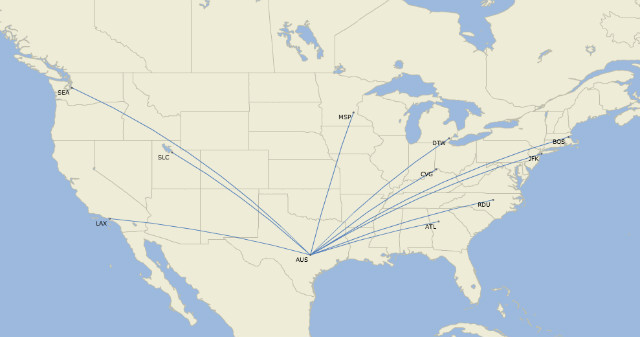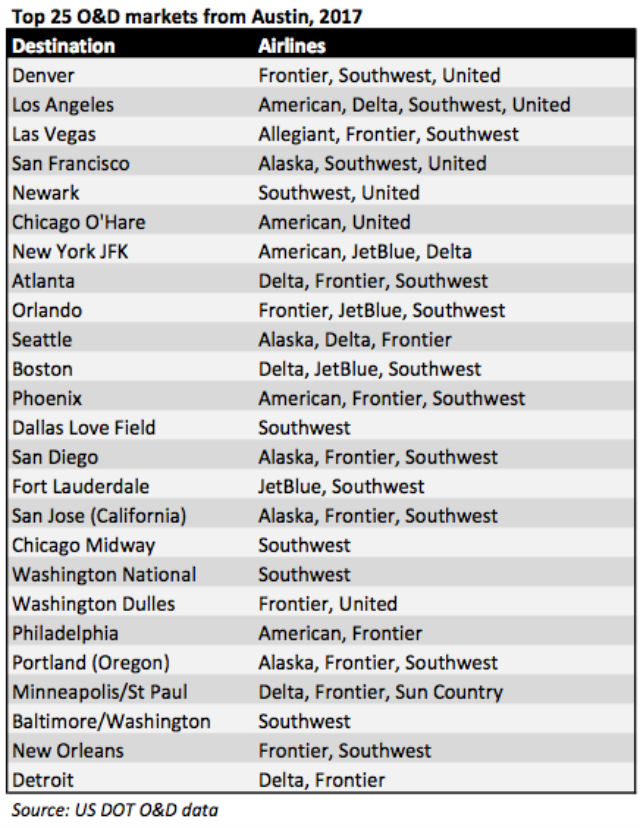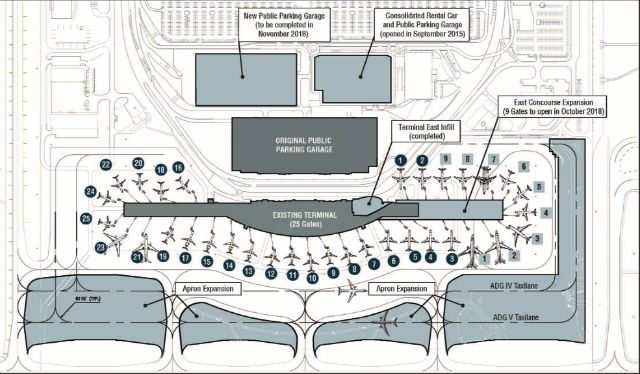Delta Air Lines is looking at Austin as a possible point of network growth in the coming years.
The Atlanta-based carrier is scheduled to increase capacity at the Texas capital by 23.5% this year – its second straight year of double-digit growth, FlightGlobal schedules data shows. It launched nonstop service to Cincinnati from Austin this year, and Boston, Raleigh/Durham and Seattle in 2017.
Next year, Delta will open a Sky Club in Austin – a move that will bring its passenger offerings at the airport in line with those it offers at hubs and focus cities, as well as larger cities around the USA, like Phoenix and San Francisco.
"We know that Delta is interested in expanding their service at the airport," says Kevin Schorr, a vice-president at Campbell-Hill Aviation that advises Austin-Bergstrom International airport on air service development. He declines to comment, however, on what destinations the airport is seeking new or increased service to, and whether they have discussed adding service in these markets with Delta.
The SkyTeam Alliance carrier connects Austin to 10 cities in the USA, including Atlanta, Los Angeles and New York John F Kennedy. However, all are either hubs or focus cities, and not spokes in its network.

Delta routes from Austin, July 2018
FlightGlobal schedules
Delta serves just seven of the top 25 markets from Austin, US Department of Transportation origin and destination (O&D) passenger data for 2017 shows. Prominent gaps include Chicago, Denver, Las Vegas and San Francisco.

Airlines serve all of the top 25 markets from Austin, with market leader Southwest Airlines flying to 18, FlightGlobal schedules show. The largest unserved market is New York LaGuardia; however, the airport's 2,414km (1,500 mile) perimeter bars nonstop flights to Austin on any day but Saturday. The largest unserved market from Austin that an airline could serve is Orange County, the data shows.
Delta declines to comment on its future plans for Austin, referring instead to its recent growth at the airport and plans to open a lounge there next year.
"We constantly look at the network," the airline says. "We scrutinise it and look for opportunities to grow."
TEXAS GAP
"One of the things that we don't have at Delta is we don't have a Texas presence… in a meaningful way," said Ed Bastian, chief executive of Delta, at an investor day in December 2017.
While he was not proposing plans to grow in Texas or Austin, Delta has a track record of targeting strategic gaps in its network and filling them with either its own metal or a joint venture partner.
For example, Delta viewed its lack of a US mainland gateway to Asia, and lagging position at London Heathrow, as gaps in its network following its merger with Northwest Airlines in 2008. It addressed the former by building up a gateway hub in Seattle and the latter by acquiring a 49% stake in Virgin Atlantic Airways in 2013, and launched an immunised joint venture with the carrier the following year.
"Our new partnership with Virgin Atlantic will strengthen both airlines and provide a more effective competitor between North America and the UK, particularly on the New York-London route, which is the largest airline route between the USA and Europe," said Richard Anderson, former chief executive of Delta, in the deal announcement in December 2012.
Industry analysts agree that Texas is a gap in Delta's domestic network with Austin, the fastest-growing market in the state in 2017, a likely candidate for growth if the airline chose to fill the gap.
"Recognised as long ago as the early 1990s, 'Silicon Valley, Texas' earned a premium fare mix reputation of a 'tech town', and also has the volume of a university town, so it is not surprising," says Robert Mann, an industry analyst with RW Mann & Company and former airline executive, on Delta's potential growth in Austin.
"I would bet not just a few CSeries 'nerd birds' end up based or through Austin, flanked by similar tech and university cities around the Delta network," he adds.
Bastian and other Delta executives have said that the airline's new Bombardier CSeries, the first of which are due by the end of the year, will fly from its hubs on both coasts and from Texas. While this can be interpreted as the aircraft being used to upgauge existing routes from 76-seat regional jets, some have suggested that it indicates plans to build a focus city in Texas.
Austin would also make a convenient transfer point with Delta's joint venture partner Aeromexico, who already serves the airport from Mexico City but not its Guadalajara or Monterrey bases.
GATE OPPORTUNITY
Austin will open nine new gates as part of its east concourse expansion in early 2019. This will increase the number of gates on the airport's main terminal to 34.

Austin airport expansion works
Austin
The airport is in negotiations with Delta and other airlines over who will use the new gates, says Schorr.
Additional gates are key to any further growth by Delta at Austin. The airline has preferential use of only three gates at the airport, which schedules show it operates up to 27 departures per day from – or nine turns per gate.
The US Transportation Research Board recommends six to eight aircraft turns per gate daily.
Delta is unlikely to be the only airline seeking use of some or all of the new gates. Every US carrier, except for JetBlue Airways, that serves Austin plans to grow seats this year. Seats on Frontier Airlines are scheduled to increase by an impressive 164%, on Alaska Airlines 73.3% and on American Airlines 15.5%, schedules show.
Even Austin's largest carrier Southwest is scheduled to grow seats by 7% in 2018, according to the data.
All of the growth at Austin is driving more than $600 million in capital investments in the airport, including the new gates, an expanded international arrivals facility and an expanded car park. Many of the improvements are scheduled to open in 2019.
Source: Cirium Dashboard



















